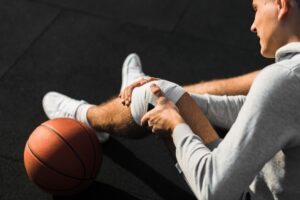Sports Injury Recovery – Proven Methods to Get Back in Action
Participating in sports is exhilarating, but it comes with the inherent risk of injuries. From sprains and strains to fractures and ligament tears, sports injuries can sideline athletes of all levels. However, proper sports injury recovery ensures that you can return to your sport safely and effectively. Understanding the best strategies for recovery from sports injury can reduce downtime and prevent re-injury, helping athletes maintain peak performance.

Understanding Sports Injuries
Sports injuries can vary widely, ranging from acute injuries caused by sudden trauma to chronic injuries that develop over time due to repetitive strain. Common examples include ankle sprains, hamstring strains, knee ligament injuries, shoulder dislocations, and stress fractures. Early intervention and correct management are critical to recovery from sports injuries. Ignoring symptoms or resuming activity too quickly can exacerbate the injury and prolong the healing process.
Immediate Steps After an Injury
The first 24 to 48 hours after an injury are crucial. Applying the R.I.C.E. method—Rest, Ice, Compression, and Elevation—can reduce swelling and pain, forming the foundation of injury recovery in sport. Resting the affected area prevents further damage, while ice helps to limit inflammation. Compression and elevation improve circulation and reduce swelling, facilitating faster healing.
It’s important to consult a healthcare professional for a proper diagnosis, especially in cases of severe pain, significant swelling, or limited mobility. Seeking professional guidance ensures that you receive a tailored recovery plan, which is vital for long-term success in sports injury recovery near me.
Rehabilitation and Physical Therapy
Once the initial pain and swelling subside, rehabilitation becomes the focus. Physical therapy is often a cornerstone of recovery from injury in sport. Therapists guide athletes through exercises that restore strength, flexibility, and mobility. These exercises are designed to mimic the movements used in your specific sport, ensuring functional recovery and minimizing the risk of re-injury.
Strengthening exercises target muscles surrounding the injured area, improving stability and support. Stretching routines restore flexibility, which is essential for maintaining range of motion. Balance and proprioception training help the body regain coordination, particularly after lower limb injuries.
Incorporating Gradual Return-to-Play Protocols
A structured, gradual return-to-play program is a critical component of recovery from sports injuries. Athletes should start with low-impact activities that do not strain the injured area and progressively increase intensity under professional supervision. Monitoring pain levels, swelling, and joint stability is essential during this phase.
For example, someone recovering from an ankle sprain may begin with stationary cycling, advance to swimming, and eventually progress to jogging before returning to sport-specific drills. Following this stepwise approach minimizes setbacks and accelerates injury recovery in sport.
Nutrition and Recovery
Nutrition plays a pivotal role in sports injury recovery. Proteins, vitamins, and minerals support tissue repair and reduce inflammation. Omega-3 fatty acids and antioxidants help combat oxidative stress and promote healing. Hydration is equally important to maintain joint health and optimize cellular function during the recovery process.
A balanced diet combined with supplements recommended by a healthcare professional can significantly improve outcomes. Proper nutrition accelerates recovery from sports injury, enabling athletes to regain strength and endurance more efficiently.
Psychological Aspects of Recovery
Recovering from a sports injury is not only a physical challenge but also a mental one. Athletes may experience frustration, anxiety, or depression due to time away from their sport. Maintaining a positive mindset and setting achievable recovery goals are essential components of successful injury recovery in sport.
Support from coaches, teammates, and mental health professionals can help maintain motivation and confidence. Visualization techniques and mindfulness exercises are also effective tools for staying engaged with the recovery process.
Preventing Future Injuries
Once you’ve recovered, preventing re-injury is key. Proper warm-ups, strength training, flexibility exercises, and correct technique reduce the risk of future setbacks. Wearing appropriate protective gear and gradually increasing training intensity also contribute to long-term sports injury recovery.
Maintaining an ongoing relationship with healthcare providers ensures that minor issues are addressed promptly, allowing athletes to continue enjoying their sport safely.
Finding Professional Support
If you’re seeking professional assistance, searching for sports injury recovery near me can connect you with qualified specialists, including sports medicine physicians, physiotherapists, and athletic trainers. These professionals offer personalized programs that optimize recovery from sports injury and support a safe return to play.
Frequently Asked Questions (FAQs)
Q1: How long does recovery from a sports injury take?
A: Recovery time varies depending on the type and severity of the injury. Minor sprains may heal within weeks, while ligament tears or fractures can take several months. Following a structured rehabilitation plan accelerates recovery.
Q2: Can I play sports while recovering from an injury?
A: It’s not recommended to resume full activity until cleared by a healthcare professional. Gradual, supervised exercises are safer and help ensure injury recovery in sport without setbacks.
Q3: What role does physical therapy play in sports injury recovery?
A: Physical therapy restores strength, flexibility, and mobility, preventing re-injury. It is a critical part of recovery from sports injuries, tailored to each athlete’s needs.
Q4: Are there ways to speed up recovery from a sports injury?
A: Combining rest, proper nutrition, targeted exercises, and professional guidance accelerates healing. Mental resilience and gradual return-to-play protocols are also essential.
Q5: Where can I find professional support for sports injury recovery?
A: Searching for sports injury recovery near me helps locate sports medicine specialists, physiotherapists, and rehabilitation centers that provide expert guidance for recovery from injury in sport.
Don’t let injuries hold you back. Get personalized sports injury recovery – visit our website https://specialtycareclinics.com/locations/bedford/ and call us at (214) 949-8918 now!
